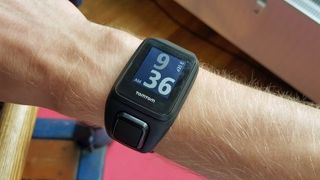Can cheap Bluetooth running headphones actually be brilliant?
And TomTom's new watch gets an early look
TomTom Spark
I've been using the new TomTom Spark watch for a week now, and it's actually starting to impress me somewhat.
For those that haven't used a TomTom running watch before (or just want to know what upgrades have come along), this new timepiece has been slimmed down from last year's Cardio and packs in step and sleep tracking to encourage you to wear it all day long.
The other big difference is the ability to add music to the mix, with a pair of Bluetooth headphones (see above for some cheap options) all you need to start LIVING IN THE FUTURE.

Because that's what this does: gives you the space-age feel. Even though music-enabled watches have been around for a while, both as GPS running choices and general smartwatches, there's still something space age about the fact I don't need a phone to still enjoy music on the go.
Add to that the fact it can read your heart rate from the wrist and only costs a shade under £200 / US$300, and it's hard not to see this as the complete running watch - especially when you hear that it also can track cycling, swimming, weight sessions and general fitness too.
But what's it like in practice? It's frustratingly close to being perfect. Irritatingly, maddeningly close.
A few subjective points aside (I don't like the fact you can only have one metric on the screen at once, with a couple of little displays for the distance and time below, but I can see how some people might love that simplicity) the TomTom Spark covers all the bases nicely - I'm a big fan of the feature that lets you race your old runs and see how far ahead or behind you are from your past.
Get daily insight, inspiration and deals in your inbox
Get the hottest deals available in your inbox plus news, reviews, opinion, analysis and more from the TechRadar team.

OK, that too isn't new, but the interface is sweet and really makes it easy to see where you are in comparison.
The sleep tracking seems accurate, the ability to see your daily / weekly fitness goals is good and I love that you can link your TomTom account instantly to Strava - a real boon.
The massive issue is the heart rate monitor: it can be so inaccurate at times. I've been using wrist-based monitors for years and usually they work fine. Sometimes they can struggle to get a reading (the arm is a terrible place to get a good pulse for these things) but adjusting the fit usually helps.
With the Spark it's a case of the sensor (which isn't the excellent Mio pulse-reading technology that adorns most similar gadgets) just not picking it up well enough.
I've been for seven runs with this thing in the last week, and on two of them it failed completely, telling me I was hitting around 100BPM when I knew I was at about 180BPM (at the Parkrun, pushing hard).
Other times it would work correctly, I'd pause it, and then when it restarted the watch just couldn't sense the pulse accurately again. It's hugely frustrating - more so when I know other reviewers who haven't had the same problems (although not put in the same mileage in testing).
I'm talking to TomTom to get the team's take on what's happening, but right now I couldn't recommend it despite the impressive nature of the music playback and fitness tracking that's been added onto an excellent watch.
- Gareth Beavis is TechRadar's Running Man of Tech, testing the latest in fitness technology in a never-ending quest to run further and faster and bringing you the results in a weekly column. If you want to say hi, he's @superbeav on Twitter, and you can see his stumblings on Strava too... plus for more data, follow him on Smashrun - if you want to sign up, please use this link (once you see the service, you'll work out why...)
- And if you want to get the full lowdown on the latest and greatest running tech, read the rest of the Running Man of Tech story here.

Gareth has been part of the consumer technology world in a career spanning three decades. He started life as a staff writer on the fledgling TechRadar, and has grown with the site (primarily as phones, tablets and wearables editor) until becoming Global Editor in Chief in 2018. Gareth has written over 4,000 articles for TechRadar, has contributed expert insight to a number of other publications, chaired panels on zeitgeist technologies, presented at the Gadget Show Live as well as representing the brand on TV and radio for multiple channels including Sky, BBC, ITV and Al-Jazeera. Passionate about fitness, he can bore anyone rigid about stress management, sleep tracking, heart rate variance as well as bemoaning something about the latest iPhone, Galaxy or OLED TV.
Most Popular



